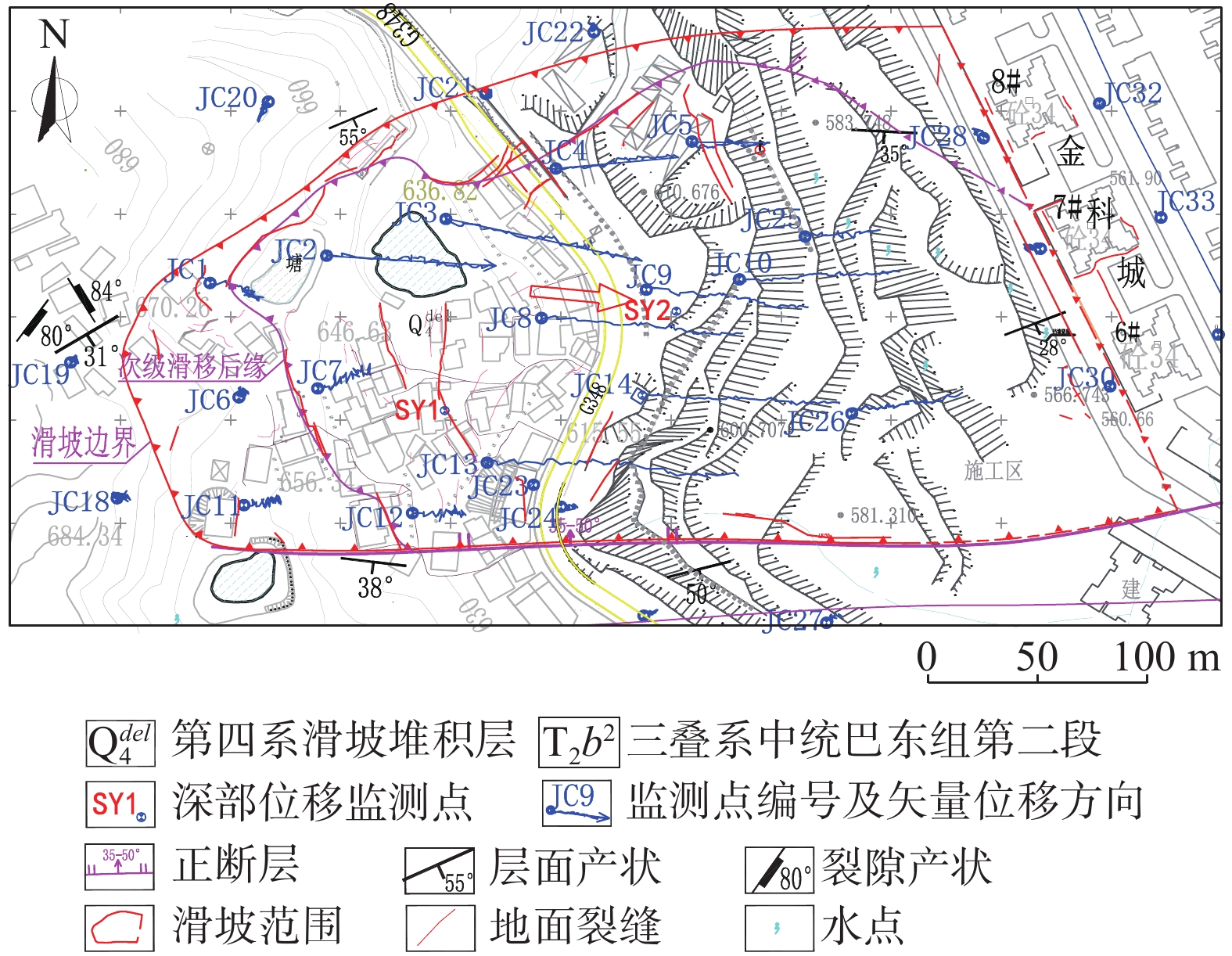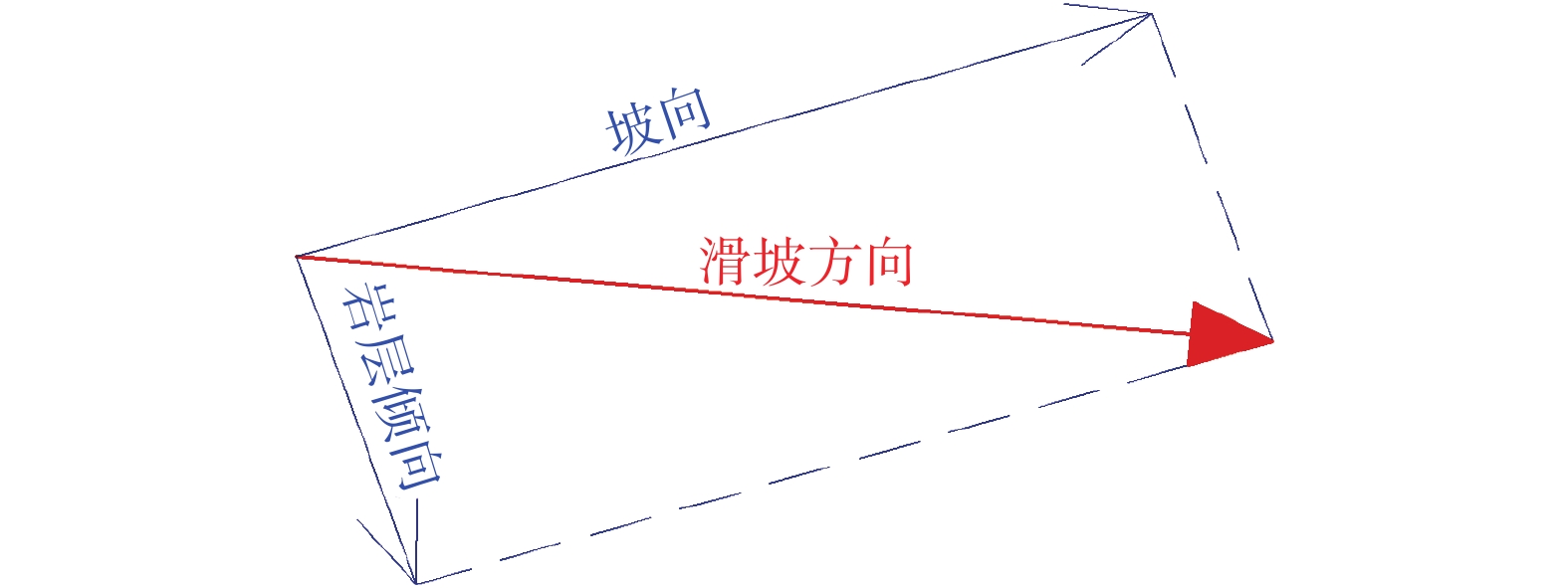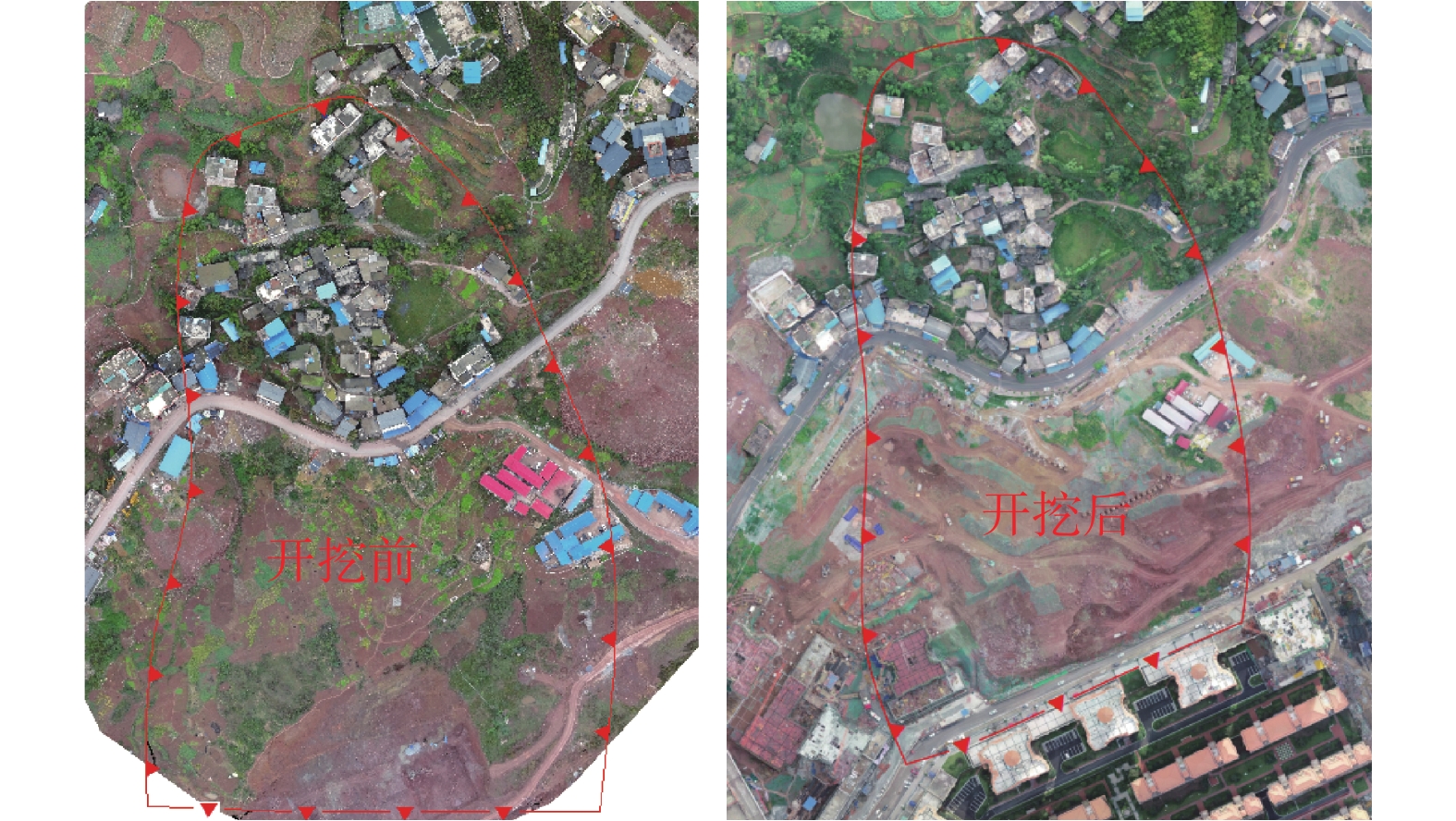Deformation characteristics and failure mechanism of large-scale obliquely dip rock landslide in the Three Gorges Reservoir Region
-
摘要: 近年来,三峡库区城集镇开发区顺斜向岩质滑坡失稳破坏现象时有发生,研究顺斜向岩质滑坡的变形破坏特征及失稳机制对防治此类滑坡具有重要意义。本文以巫山县白杨湾滑坡为例,通过现场踏勘、钻探和多种监测手段,对这一典型顺斜向岩质滑坡的变形破坏特征及失稳机制进行了深入研究。此滑坡所处地层为巴东组第二段泥岩,岩体破碎,地下水较丰富。滑坡岩层向右边界倾斜,右边界受断层控制,断层面与岩层面相交切割形成楔形体顺斜向滑移。滑坡体积约320×104 m3,滑动方向与岩层倾向夹角60°。受坡脚开挖和坡体建筑荷载等人类工程活动的影响,滑坡于2019年7月开始出现显著变形,滑坡中部的位移速率达到2~5 mm/d。2019年9月中旬,滑坡前部设置应急抗滑桩后,滑坡变形开始减缓至0~0.5 mm/d。白杨湾滑坡对城集镇开发区金科城造成巨大威胁,建议采取“搬迁避让+工程治理+专业监测”的防治对策。本文的研究成果对指导三峡库区顺斜向岩质滑坡防治和人工开挖诱发滑坡的防治具有重要借鉴意义。Abstract: In recent years, the tangential rock landslides occurred frequently in the urban area of the Three Gorges Reservoir region. Therefore, it is of great significance to study the deformation and failure characteristics and failure mechanism for the prevention and control of the tangential rock landslides. In this paper, taking the Baiyangwan landslide in Wushan Town as a case study, the deformation characteristics and failure mechanism are studied in detail, by field investigation, drilling works and in-situ comprehensive monitoring systerm. The stratum of the landslide is mudstone in the second member of the Badong Formation, with abundant groundwater and broken rock mass. The rock layer incline to the right boundary, which is cut by a fault, and the multi-layered weak interlayer forms a multi-stage slip zone. Therefore, wedge-shaped sliding surface was easily developed. The volume of the landslide is about 320×104 m3, and the angle between the sliding direction and the rock formation attitude is 60°. Affected by human engineering activities, such as slope excavation and construction loading, the significant deformation began in July 2019, and the displacement velocities in the middle part reached to 2~5 mm/day. In September 2019, the emergency anti-slide pile project was set at the toe part of the landslide, after that the deforamtion velocities of the landslide slow down to 0~0.5 mm/day. The Baiyangwan landslide seriously threaten to the Jinke community, and the prevention and control measures of "relocation avoidance + project management + professional monitoring" were recommended to adopt to the landslide. The research results of this paper are of great significance for guiding the prevention of tangential rock landslides in the Three Gorges reservoir area and landslides induced by excavation.
-
-
-
[1] 黄润秋, 赵建军, 巨能攀, 等. 汤屯高速公路顺层岩质边坡变形机制分析及治理对策研究[J]. 岩石力学与工程学报,2007,26(2):239 − 246. [HUANG Runqiu, ZHAO Jianjun, JU Nengpan, et al. Study on deformation mechanism and control method of bedding rock slope along Tangtun expressway[J]. Chinese Journal of Rock Mechanics and Engineering,2007,26(2):239 − 246. (in Chinese with English abstract) DOI: 10.3321/j.issn:1000-6915.2007.02.003 [2] YIN Y P, SUN P, ZHANG M, et al. Mechanism on apparent dip sliding of oblique inclined bedding rockslide at Jiweishan, Chongqing, China[J]. Landslides,2011,8(1):49 − 65. DOI: 10.1007/s10346-010-0237-5
[3] TANG H, ZOU Z, XIONG C, et al. An evolution model of large consequent bedding rockslides, with particular reference to the Jiweishan rockslide in Southwest China[J]. Engineering Geology,2015,186:17 − 27.
[4] ZHANG S, ZHU Z, QI S, et al. Deformation process and mechanism analyses for a planar sliding in the Mayanpo massive bedding rock slope at the Xiangjiaba Hydropower Station[J]. Landslides,2018,15(10):2061 − 2073. DOI: 10.1007/s10346-018-1041-x
[5] 殷跃平. 长江三峡库区移民迁建新址重大地质灾害及防治研究[M]. 北京: 地质出版社, 2004. YIN Yueping. Study on the major geological hazards and prevention of the new relocation site in the Three Gorges Reservoir area of the Yangtze River[M]. Beijing: Geological Publishing House, 2004. (in Chinese)
[6] 邹宗兴, 唐辉明, 熊承仁, 等. 大型顺层岩质滑坡渐进破坏地质力学模型与稳定性分析[J]. 岩石力学与工程学报,2012,31(11):2222 − 2231. [ZOU Zongxing, TANG Huiming, XIONG Chengren, et al. Geomechanical model of progressive failure for large consequent bedding rockslide and its stability analysis[J]. Chinese Journal of Rock Mechanics and Engineering,2012,31(11):2222 − 2231. (in Chinese with English abstract) DOI: 10.3969/j.issn.1000-6915.2012.11.010 [7] SANTANGELO M, MARCHESINI I, CARDINALI M, et al. A method for the assessment of the influence of bedding on landslide abundance and types[J]. Landslides,2015,12(2):295 − 309. DOI: 10.1007/s10346-014-0485-x
[8] 邓弟平, 杨成. 达州环城路加油站顺层岩质边坡稳定性分析[J]. 土工基础,2019,33(6):647 − 649. [DENG Diping, YANG Cheng. Stability analysis of a syncline bedded rock slope near a gas station[J]. Soil Engineering and Foundation,2019,33(6):647 − 649. (in Chinese with English abstract) [9] 余姝, 张枝华, 黄波林, 等. 三峡库区青石-抱龙段顺层灰岩库岸坡变形破坏机理[J]. 中国地质灾害与防治学报,2019,30(3):19 − 23. [YU Shu, ZHANG Zhihua, HUANG Bolin, et al. Deformation mechanism of bedding limestone bank slope from Qingshi to Baolong, the Three Gorget Area[J]. The Chinese Journal of Geological Hazard and Control,2019,30(3):19 − 23. (in Chinese with English abstract) [10] 蒋正, 倪化勇, 宋志. 重庆丰都县城区红层边坡变形破坏模式与稳定性评价[J]. 中国地质灾害与防治学报,2018,29(6):24 − 32. [JIANG Zheng, NI Huayong, SONG Zhi. Deformation and failure modes and stability assessment of red bed slope in the urban area of Fengdu , Chongqing[J]. The Chinese Journal of Geological Hazard and Control,2018,29(6):24 − 32. (in Chinese with English abstract) [11] 卫童瑶, 殷跃平, 高杨, 等. 三峡库区巫山县塔坪H1滑坡变形机制[J]. 水文地质工程地质,2020,47(4):74 − 81. [WEI Tongyao, YIN Yueping, GAO Yang, et al. Deformation mechanism of the Taping H1 landslide in Wushan County in the Three Gorges Reservoir area[J]. Hydrogeology & Engineering Geology,2020,47(4):74 − 81. (in Chinese with English abstract) [12] 冯君, 周德培, 江南, 等. 微型桩体系加固顺层岩质边坡的内力计算模式[J]. 岩石力学与工程学报,2006,25(2):284 − 288. [FENG Jun, ZHOU Depei, JIANG Nan, et al. A model for calculation of internal force of micropile system to reinforce bedding rock slope[J]. Chinese Journal of Rock Mechanics and Engineering,2006,25(2):284 − 288. (in Chinese with English abstract) DOI: 10.3321/j.issn:1000-6915.2006.02.010 [13] 陈训龙, 龚文惠, 钟旭晗, 等. 水平和竖向地震作用下顺层岩质边坡动力可靠性分析[J]. 土木工程学报,2017,50(10):91 − 98. [CHEN Xunlong, GONG Wenhui, ZHONG Xuhan, et al. Dynamic reliability analysis of bedding rock slopes under horizontal and vertical earthquake actions[J]. China Civil Engineering Journal,2017,50(10):91 − 98. (in Chinese with English abstract) [14] 张孝伟. 顺层岩质边坡隧道破坏模式与防治对策[J]. 西部探矿工程,2019,31(10):184 − 186. [ZHANG Xiaowei. Failure modes and preventive measures of tunnel on consequent bedding rock slope[J]. West-China Exploration Engineering,2019,31(10):184 − 186. (in Chinese with English abstract) DOI: 10.3969/j.issn.1004-5716.2019.10.064 [15] E HOEK, J W BRAY. 岩石边坡工程[M]. 北京: 冶金工业出版社, 1977. E HOEK, J W BRAY. Rock slope Engineering[M]. Beijing: Metallurgical Industry Press, 1977. (in Chinese)
[16] DAI F C, TU X B, XU C, et al. Rock avalanches triggered by oblique-thrusting during the 12 May 2008 Ms 8.0 Wenchuan earthquake, China[J]. Geomorphology,2011,132(3/4):300 − 318.
[17] 张倬元, 王士天, 王兰生. 工程地质分析原理[M]. 北京: 地质出版社, 1981. ZHANG Zhuoyuan, WANG Shitian, WANG Lansheng. Principle of engineering geology analysis[M]. Beijing: Geological Publishing House, 1981. (in Chinese)
[18] 孙红月, 尚岳全. 顺斜向坡变形破坏特征研究[J]. 工程地质学报,1999,7(2):141 − 146. [SUN Hongyue, SHANG Yuequan. Study on deformation of failure of down dip slopes[J]. Journal of Engineering Geology,1999,7(2):141 − 146. (in Chinese with English abstract) DOI: 10.3969/j.issn.1004-9665.1999.02.007 [19] 程谦恭, 张倬元, 黄润秋. 侧翼与滑床复合锁固切向层状岩质滑坡动力学机理与稳定性判据[J]. 岩石力学与工程学报,2004,23(11):1874 − 1882. [CHENG Qiangong, ZHANG Zhouyuan, HUANG Runqiu. Dynamics and stability criterion of oblique layered rocky landslide under lockup with combination of flank and bedding plane[J]. Chinese Journal of Rock Mechanics and Engineering,2004,23(11):1874 − 1882. (in Chinese with English abstract) DOI: 10.3321/j.issn:1000-6915.2004.11.017 [20] 蒋先念, 王 恒, 杨长明, 等. 重庆市巫山县巫峡镇白杨湾滑坡应急抢险勘查报告[R].重庆市二零八勘察设计院, 2019. JIANG Xiannian, WANG Heng, YANG Changming, et al. Investigation report on emergency rescue of Baiyangwan landslide in Wuxia Town, Wushan County, Chongqing[R]. Chongqing 208 Survey and Design Institute, 2019. (in Chinese)
[21] 张茂省. 发挥新型举国体制优势提高地质灾害防治能力[J]. 西北地质,2019,52(2):Ⅰ − Ⅱ. [ZHANG Maosheng. Maximising the advantages of the new national system for improving the ability to prevent and mitigate geological disasters[J]. Northwestern Geology,2019,52(2):Ⅰ − Ⅱ. (in Chinese with English abstract) [22] 张茂省, 薛强, 贾俊, 等. 山区城镇地质灾害调查与风险评价方法及实践[J]. 西北地质,2019,52(2):125 − 135. [ZHANG Maosheng, XUE Qiang, JIA Jun, et al. Methods and practices for the investigation and risk assessment of geo-hazards in mountainous towns[J]. Northwestern Geology,2019,52(2):125 − 135. (in Chinese with English abstract) [23] 刘畅, 张平松, 杨为民, 等. 税湾地震黄土滑坡的岩土动力特性及其稳定性评价[J]. 西北地质,2020,53(4):176 − 185. [LIU Chang, ZHANG Pingsong, YANG Weimin, et al. Geotechnical dynamic characteristics and stability evaluation of loess landslides in Shuiwan Earthquake, Tianshui, Gansu[J]. Northwestern Geology,2020,53(4):176 − 185. (in Chinese with English abstract) [24] 李滨, 张青, 王文沛, 等. 金沙江乌东德水电站坝区高陡边坡地质灾害监测预警研究[J]. 地质力学学报,2020,26(4):556 − 564. [LI Bin, ZHANG Qing, WANG Wenpei, et al. Geohazard monitoring and risk management of high-steep slope in the Wudongde dam area[J]. Journal of Geomechanics,2020,26(4):556 − 564. (in Chinese with English abstract) -
期刊类型引用(7)
1. 蔡小东. 暴雨条件下赣南山区高速公路高边坡稳定性研究. 价值工程. 2025(04): 139-141 .  百度学术
百度学术
2. 赖波,江金进,江山,江宁,赵风顺. 珠海市南水镇金龙边坡变形破坏特征及稳定性评价. 城市地质. 2024(01): 20-28 .  百度学术
百度学术
3. 王玉刚,袁伟. 基于遗传算法的地下暗挖工程边坡稳定性分析. 大众标准化. 2023(15): 103-105 .  百度学术
百度学术
4. 林逸晖,李广涛,杨天雨,乔登攀,王俊,张希,赵怀军. 基于PCA-RF的边坡稳定性预测. 化工矿物与加工. 2023(12): 59-65 .  百度学术
百度学术
5. 王猛,何德伟,贾志宏,胡至华. 基于多源遥感数据的高位滑坡特征分析——以广元市利州区荣山镇岩窝村滑坡为例. 中国地质灾害与防治学报. 2023(06): 57-68 .  本站查看
本站查看
6. 刘顺青,蔡宇宸,程涛,周萍,王旭畅. 降雨入渗条件下下蜀土边坡稳定性分析. 地质灾害与环境保护. 2022(02): 32-37 .  百度学术
百度学术
7. 郭世兴. 关于崩滑地质灾害抢险治理工程的斜坡稳定性分析. 世界有色金属. 2021(21): 203-204 .  百度学术
百度学术
其他类型引用(1)





 下载:
下载:










 邮件订阅
邮件订阅 RSS
RSS